|
|
A lot of time, effort, and funds have been spent on programs evaluating the threat of extinction to species around the world. Yet insects have not benefited from these programs, which have largely focused on more ‘charismatic’ species such as mammals, birds, amphibians, and reptiles. This gap is clearly shown by the fact that 42 percent of vertebrates have been assessed by the International Union for the Conservation of Nature (IUCN), and only 0.3 percent of invertebrates.
Given this dearth of knowledge regarding the threat level of extinction to invertebrates, conservationists concerned about the current extinction crisis have largely had to do without hard data on insects and other invertebrates to make predictions regarding the level of extinction possible.
A new study in Biological Conservation has begun the long and difficult process of evaluating the state of insect populations around the globe, focusing on the order of Odonata, which includes dragonflies and damselflies.
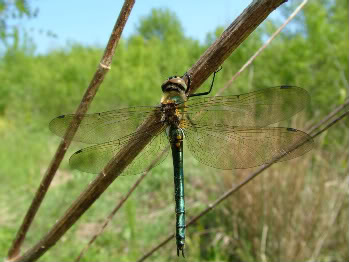 Compared to other groups of insects dragonflies are relatively well known. It was therefore a surprise when in 2001 a completely unknown species was discovered in Europe. This species, the Bulgarian Emerald(Somatochlora borisi), is confined to large brooks and small rivers in the hills of Southeast Bulgaria, Eastern Greece and European Turkey. This area is largely undisturbed and mainly used for extensive wood production and rearing goats and sheep. Recent prolonged spells of hot and dry weather have led to the desiccation of brooks and rivers. The expected increased impact of climate change caused this species to be assessed as Vulnerable. Photo by: Vincent Kalkman. |
Assessing the threat
Viola Clausnitzer, one of the paper’s lead authors, told mongabay.com that assessing the Odonata order was a natural choice to begin this process.
“Odonata are an easy to study group: they are active at daytime, have a striking appearance and courtship behavior, the taxonomy is more or less solved (unlike most other insect groups), they are used as indicator organisms for assessments, they can serve as flag-ship species for environmental health (‘guardians of the watershed’),” Clausnitzer said, a geographer at the Phillips University of Marburg, Germany. “For most other insect groups a global approach is not yet possible because of problems with taxonomy and too many yet undescribed species.”
To determine the overall threat level to dragonflies and damselflies, researchers assessed individual threat levels for 1,500 randomly selected species out of the total 5,680 described Odonata species (26.5 percent). Clausnitzer and her team assessed threat status by looking at the availability and state of habitat within each species’ range.
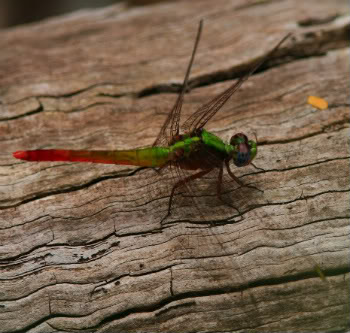 Discovered in 1952, the dragonfly Viridithemis viridula was described from a single female in western Madagascar. Its name is derived from its uniformly green colour, which is unusual in similar dragonflies. The species remained unseen until a female was photographed at the world famous Allée de Baobabs near Morondava in 2002. Two years later another was seen in the nearby Kirindy Forest. With so little to go by, and no ecological information, it is impossible to ascertain the status of Viridithemis viridula. Apparently the species is scarce and confined to the fragmented dry forests of western Madagascar, but at present it is recorded as Data Deficient (DD) on the IUCN Red List. Over 170 species of dragonflies and damselflies are known from Madagascar, four-fifths of which occur nowhere else. More than a hundred of these are potentially threatened, but are also virtually unknown. Text credit: Klaas-Douwe B. Dijkstra. Photo by: Mike Crewe. |
Researchers were surprised to find that only 10 percent of these species appeared to be under threat of extinction. This was a better than expected, especially considering that 31 percent of amphibians, 20 percent of mammals, and 12 percent of birds are threatened.
The highest ratio of threatened Odonata species were found in Australia and islands off Southeast Asia. Australian species are increasingly threatened by climate change’s affect on freshwater environments, while island dragonflies and damselflies face constricted habitats and deforestation. To date only two Odonata species has been recorded going extinct in modern times, both on islands: Megalagrion jugorum from Maui and Sympetrum dilatatum from Saint Helena.
Data Deficient
In addition to 10 percent of dragonflies and damselflies considered threatened, the researchers also found that 35 percent, or 527 species, were classified as Data Deficient. In other words, the scientists simply did not have enough information on the species to make determination of their status.
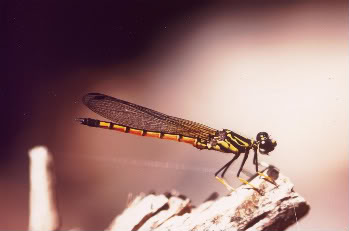 The Golden Dancing Jewel owes its name to the golden colour and to the dancing mating flights males perform if a female is present. The inflated and coloured legs are used to attract females and to frighten other males. This conspicuous behaviour is similar throughout all representatives of this genus. The Golden Dancing Jewel is found along clear and fast running streams and rivers in the Eastern Arc Mountains of Tanzania (e.g. Usambara Mts, Uluguru Mts, Udzungwa Mts). These forest are highly fragmented and suffer deforestation and water pollution by the growing population in and around the forests. Currently the species is considered as Vulnerable on the IUCN Red List. Text and photo by: Viola Clausnitzer. |
“The higher the Data Deficient category the poorer the results,” Clausnitzer admits. “But the percentage of Data Deficient species was equally high in the global amphibian assessment and is only lower with birds and mammals. Nevertheless much effort is needed to lower the number of Data Deficient species.”
While the percentage of Data Deficient species is relatively high for vertebrates, Clausnitzer says that it is unique for invertebrates.
“If you assess other groups [of invertebrates, the percentage of Data Deficient] will be much higher. Still, the data deficient areas are tropical countries and much more surveys, ecological and biodiversity field work and taxonomica work is necessary to lower the Data Deficient category,” Clausnitzer says. Nearly 60 percent of the world’s Odonata species live in the Neotropics and the Indo-Malayan realms.
According to the paper, the percentage of Data Deficient species could raise the number of threatened Odonata species to approximately fifteen percent, rather than ten, but this is still only half the number of threatened amphibians.
These findings call into question predictions of the current extinction crisis that tend toward the higher end. For example, even if fifteen percent of Odonata species are threatened it is difficult to imagine an extinction crisis that exceeds this percentage if other insect species are similar.
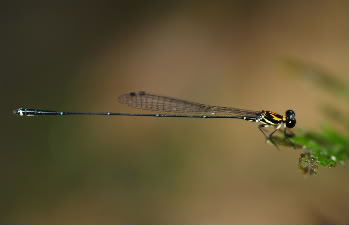 This delicate damselfly was assessed as Data Deficient (DD) on the IUCN Red List, because it was known from only a few males from two localities close to each other in the Amazon forest of northern Peru. During a visit to the Research Station of Tiputini, located in eastern Ecuador this last January, R. W. Garrison and Natalia von Ellenrieder found it also inhabiting several narrow streams within the Ecuadorian forest. This discovery considerably enlarges the range of distribution of this beautiful damselfly, and hopefully many other rare species of Odonates which are insufficiently known are found more widely distributed upon further search of this vast and rich forest. The adults fly very close to the water surface, and perch horizontally on sticks and leaves overhanging the water. In the shaded streams they are rendered inconspicuous, and can usually be noticed only after examination of the vegetation growing along the stream banks. Text credit: Natalia von Ellenrieder. Photo by: Rosser W. Garrison. |
“Some of the predictions seem to be largely exaggerated,” Clausnitzer says, adding that “insects can survive in small pockets of habitats.”
In addition dragonflies and damselflies do not face the same hunting pressures as many mammals, birds, reptiles, and amphibians. The bushmeat and wildlife trafficking has become one of the leading causes behind species endangerment worldwide, but it is a threat that insects, other than butterflies, have avoided.
Conservation and research
Although not as media-friendly as polar bears and pandas, Clausnitzer believes that conserving dragonflies and damselflies is important to saving ecosystems in general.
“Odonata are key-predators and are sensitive to changes to the aquatic and terrestrial environment. Because they are easy to observe and survey they are excellent indicator organisms to monitor environmental health. Since most people know dragonflies, they are good flag-ship species to teach people about the importance of conservation and monitoring. Thus dragonflies can be regarded as ‘guardians of the watershed’,” Clausnitzer says.
To conserve these ‘guardians’—and the ecosystems they inhabit—Clausnitzer urges “serious global attempts to protect forests, springs, streams and rivers. In Europe we can currently watch an increase in water quality, while third world countries, which often rely directly on river water, have a drastic decrease in water quality and availability. For example it would help to have a 10m wide strip along streams and rivers, which remains untouched.”
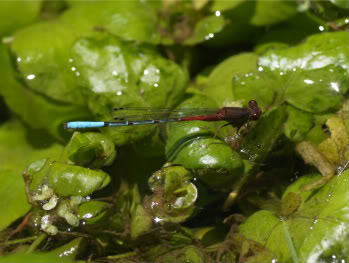 In the southern limits of the South American cloud forest in northwestern Argentina, this damselfly adds a colorful note to seepages, pools, and still waters at stream edges, from mountain rain forest to highland grasslands. Males patrol flying close to water’s surface and perching on leaves of emergent aquatic vegetation. Pairs in copula land on grasses and bushes near water, and females oviposit in water plants while still in tandem. Although this damselfly is not rare in the area, reduction and fragmentation of its habitat by increased modification and loss of aquatic environments caused by selective logging and clear-cutting of the forest for agriculture and petroleum prospecting threaten its future prosperity, and thus it was assessed as Near Threatened (NT) on the Red List. Photo and text by: Natalia von Ellenrieder. |
Still, there is a lot more research and work that needs to be done. “Odonata only comprise a small invertebrate order, with above-average dispersal ability and relatively wide distribution ranges,” Clausnitzer and the other authors write in the paper. “For conservation science and policy to be truly representative of global biodiversity a representative cross-section of invertebrates needs to be included.”
What insect orders would they recommend next?
“In terms of feasibility grasshoppers and butterflies might be possible,” Clausnitzer said. “But more important would be an assessment of hymenoptera, since these play an important role in pollination and as predators of pest-insects (key ecosystem-services).”
Hymenoptera is a large order of insects, comprising everything from bees and ants to sawflies and wasps.
Clausnitzer says that in order to move forward there needs to be “funding for more surveys, field work and taxonomic work,” adding that, “nevertheless with the current economic situation it is even more difficult to get funding for basic biodiversity research.”
If scientists are ever to make accurate estimates regarding the extinction crisis already under way, more research will be necessary.
Viola Clausnitzer, Vincent J. Kalkman, Mala Ramc, Ben Collen, Jonathan E.M. Baillie, Matjaz Bedjanic,
William R.T. Darwall, Klaas-Douwe B. Dijkstra, Rory Dow, John Hawking, Haruki Karube,
Elena Malikova, Dennis Paulson, Kai Schütte, Frank Suhling, Reagan J. Villanueva,
Natalia von Ellenrieder, Keith Wilson. Odonata enter the biodiversity crisis debate: The first global assessment
of an insect group. Biological Conservation 142 (2009) 1864–1869. doi:10.1016/j.biocon.2009.03.028.
Related articles
The unknown role of coextinctions in the current extinction crisis

(05/28/2009) Scientists have long recognized ‘coextinctions’ as a major concern when it comes to the current mass extinction crisis. Despite such recognition, however, the role of coextinctions remains largely mysterious and little-studied. A new paper attempts to address this by settling what is known (and unknown) about the phenomenon of coextinctions and where research needs to go next.
Updated Red-List: 192 birds are Critically-Endangered
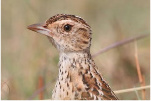
(05/14/2009) In this year’s updated IUCN Red List on birds, six species were down-listed from Critically Endangered to Endangered, but eight species were up-listed to Critically Endangered, leading to the highest number of Critically Endangered birds ever on the list. In all 1,227 bird species (12 percent) are currently considered threatened with global extinction.
Symposium tackles big question: how many species will survive our generation
(01/16/2009) Nine scientists dusted off their crystal balls Monday at the National Museum of Natural History in Washington DC, weighing in on the future of the world’s tropical forest. Despite the most up-to-date statistics, prognosis for the future of tropical forests varied widely. In the last few years a schism has occurred among biologists regarding the future of the tropics. No tropical scientist denies that rainforests and the species which inhabit them face unprecedented threats; neither do they argue that some of these forested regions and species will likely not survive the next fifty years. What has sparked debate, sometimes heated, is how bad will is it really? When the dust settles, what percentage of species will survive and how much forest will remain?